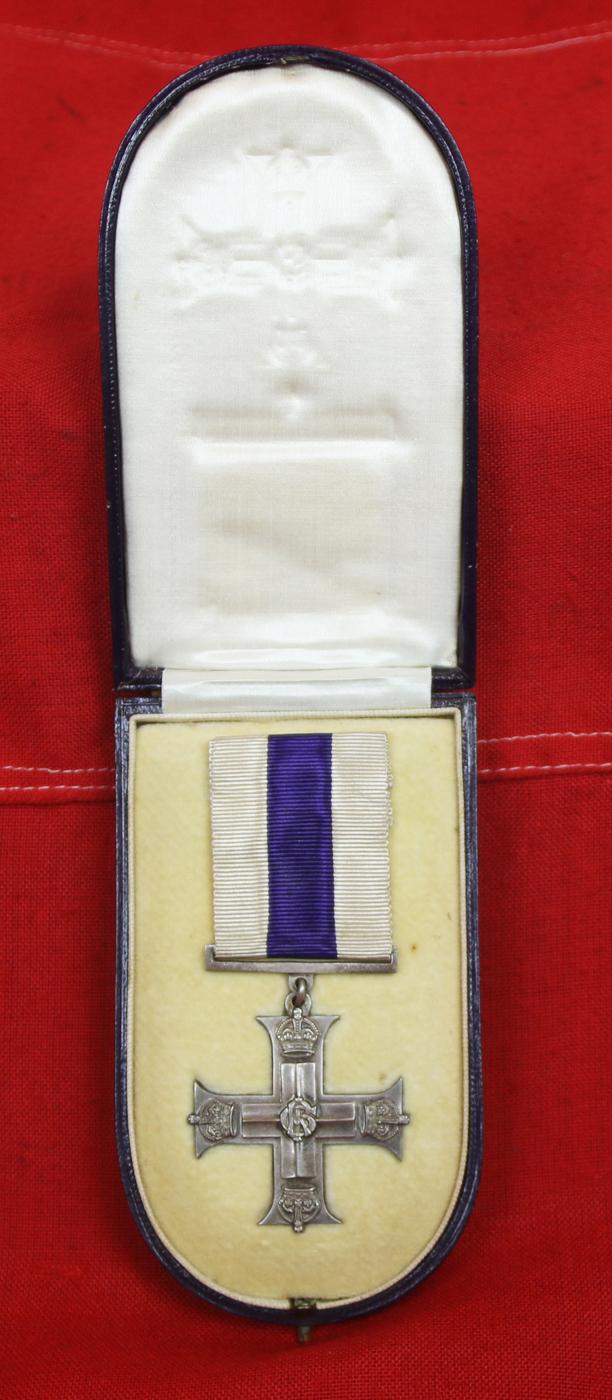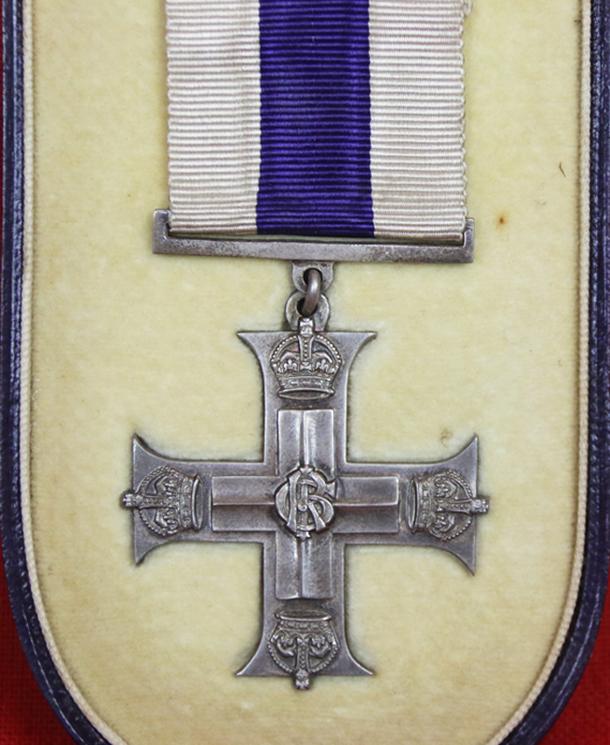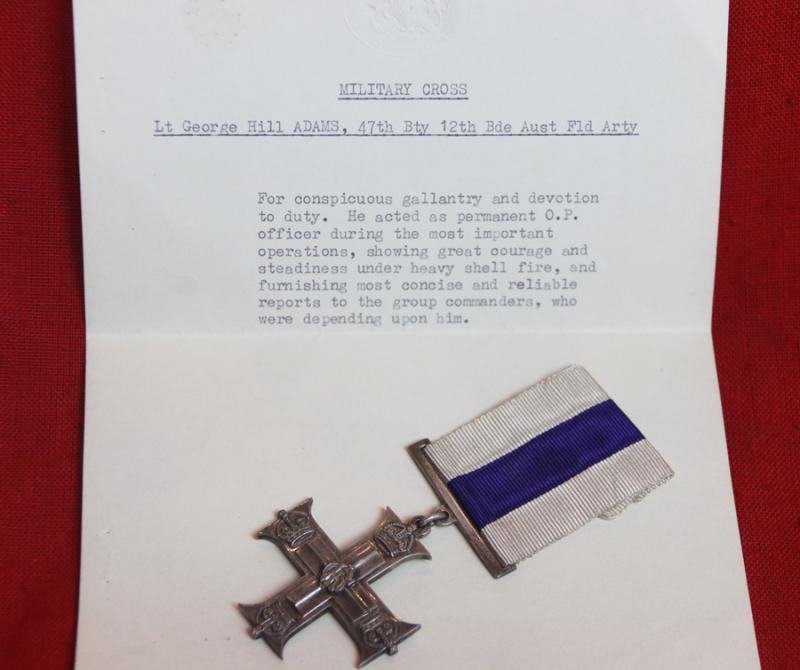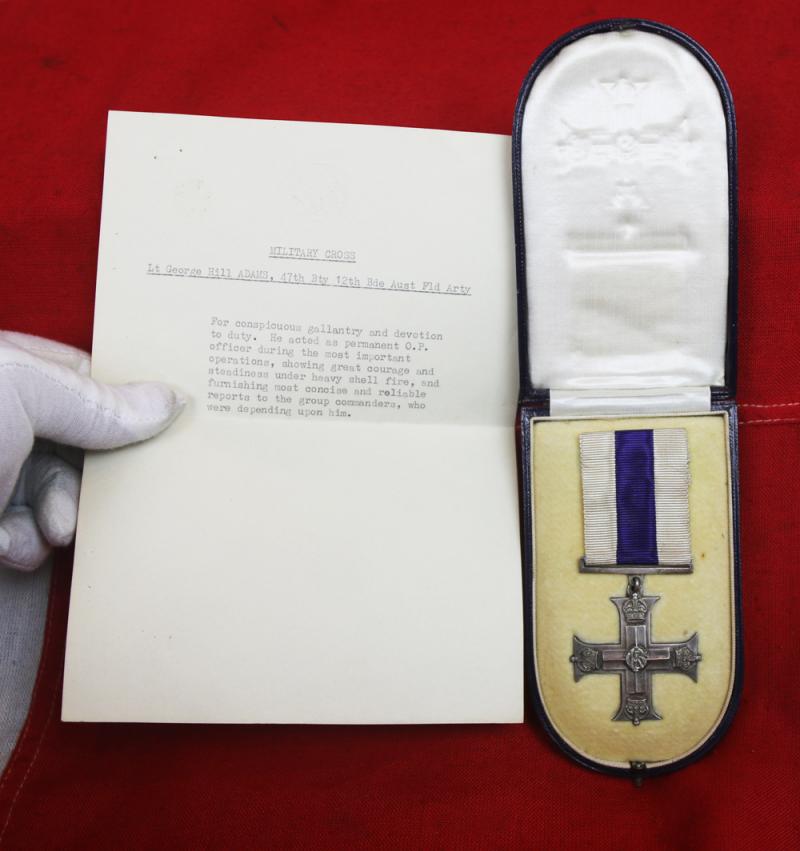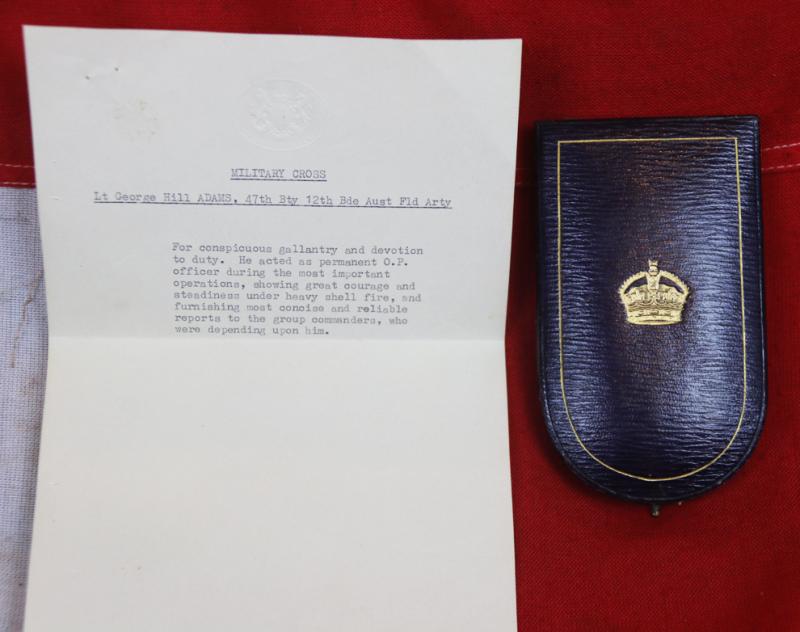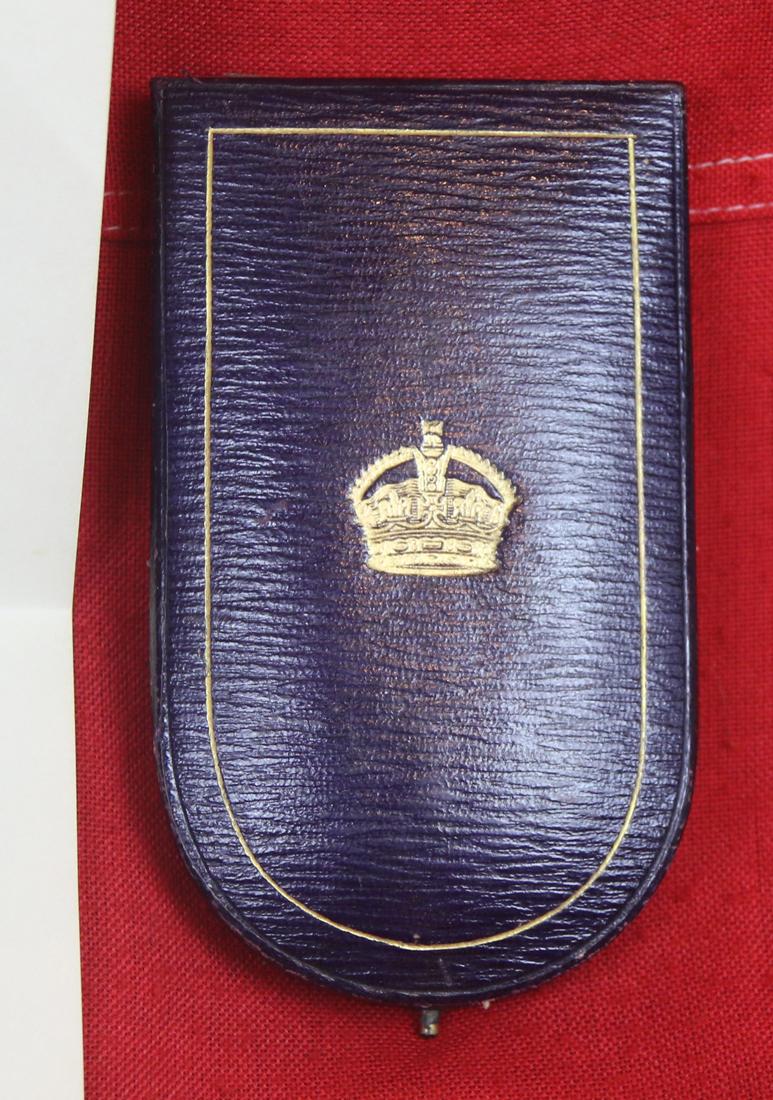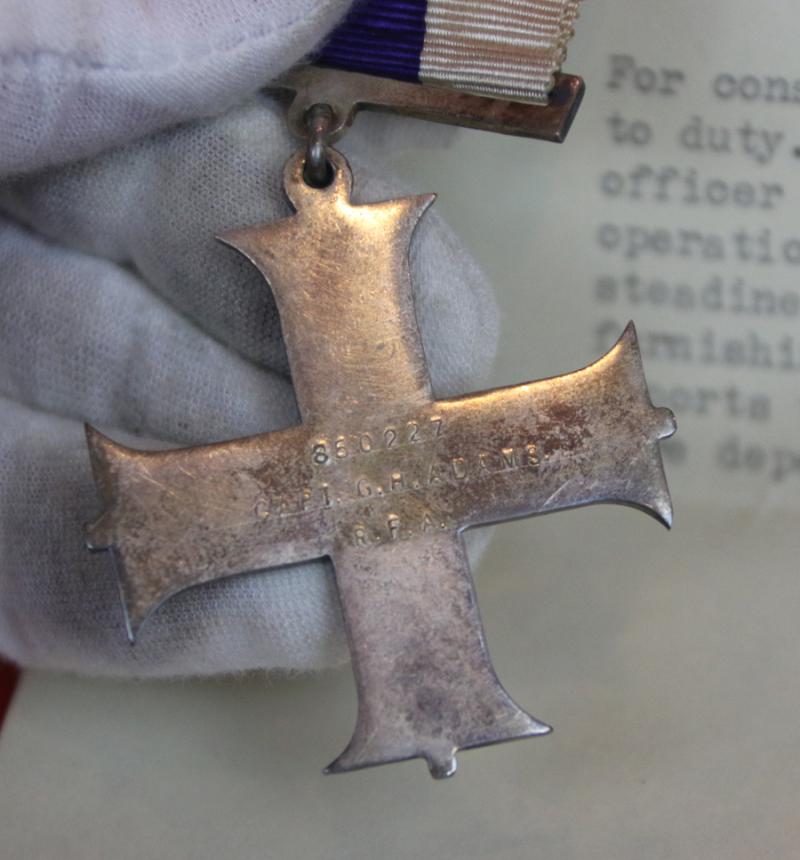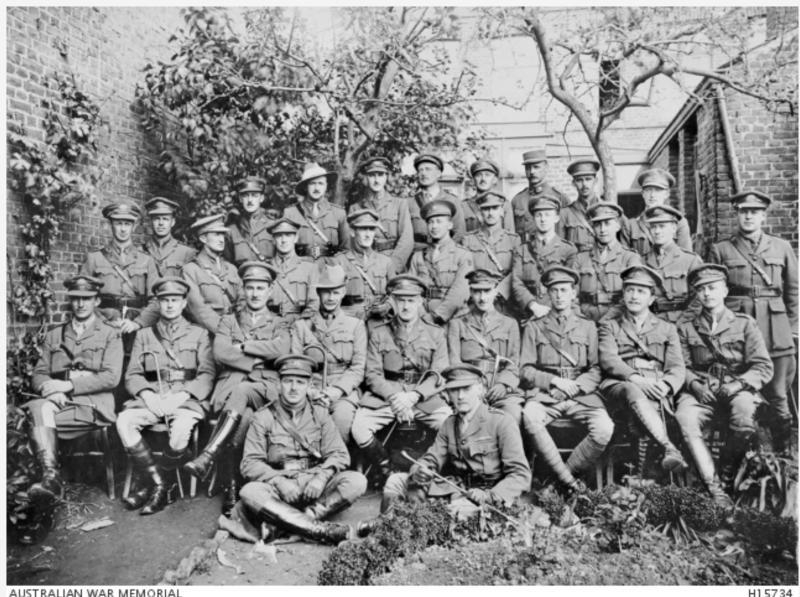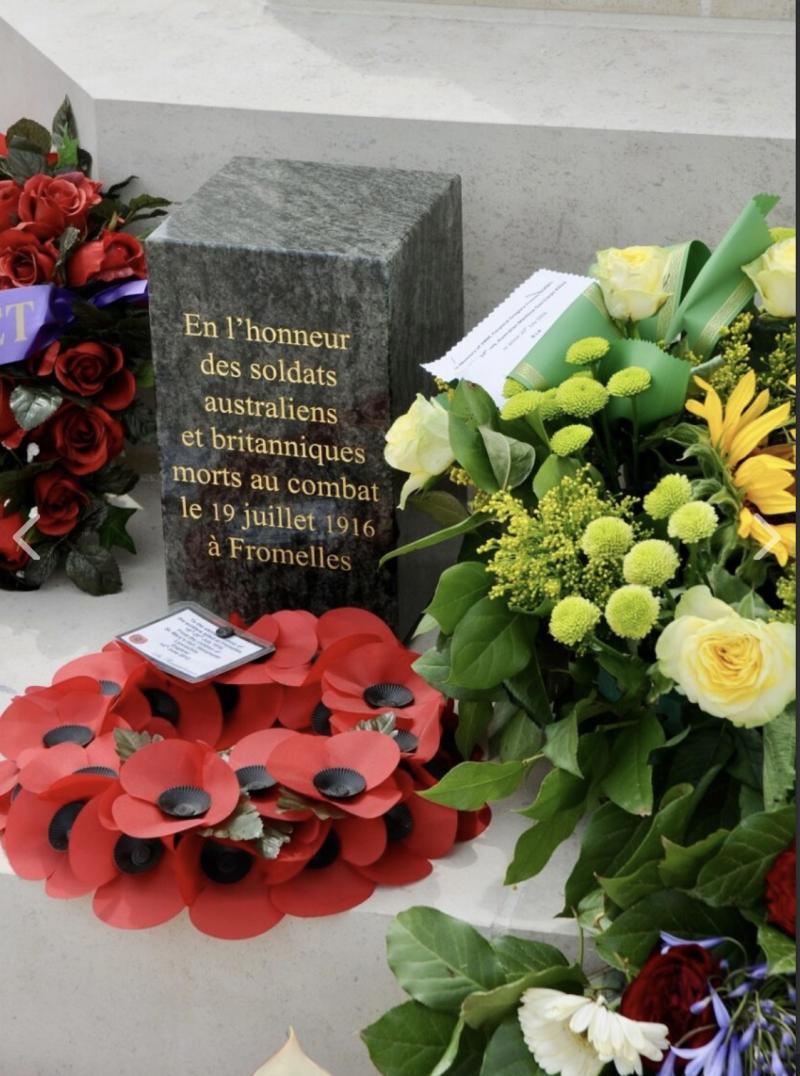A Superb & Rare, Original Australian WW1 Military Cross for Conspicuous Gallantry Awarded To an Australian Lieutenant/ Capt. of 12th Field Artillery 47th Battery, Named. In Original Case & Government Certificate. He is Named On The Australian Memorial
One of Australia’s Great War heroes. Enlisted as a private in 1915, and ended the war a Captain.
Gazette reads, "Lt. Adams was awarded the Military Cross while serving with the 47th Bty, 12th BDE, Aust. Fld. Arty For Conspicuous Gallantry, and Devotion to Duty. He acted as permanent OP officer during the most important operations, showing great courage and steadiness under heavy shellfire, and furnishing most concise and reliable reports to the group commanders, who were depending upon him"
In original medal case, and his M.C. award gazette details, typed upon a British government seal impressed stamped letter. From the former important renown collection of decorations and medals of the late Captain G.D.Hinks, T.D.,F.R.S.A. The original Glendinings auction catalogue will accompany the medal, and its original 1994 purchase receipt.
Lt George Hill Adams, Military Cross (MC)
MC AIF.
London Gazette
16 August 1917 on page 8388 at position 1
Commonwealth Gazette
20 December 1917 on page 3372 at position 26
Awarded for an act or acts of conspicuous gallantry
The MC was Awarded during active operations against the enemy on land, to captains or officers of lower rank up to warrant officers. (NCOs or other ranks instead received the Military Medal.)
G. H. ADAMS enlisted in May and embarked from Australia in November 1915 as Corporal in 2nd D.A.C., arriving in Egypt the following December; he was there transferred to 12th A.F.A. Brigade in March 1916, took part in the operations of the Egyptian Expeditionary Force and received his commission on 11th April.
Upon transfer to France in June he took part in the Fleurbaix battle on 19th July 1916, and on 1st August 1916 was promoted to Lieutenant. He also took part in further fighting of the Somme Winter in 1916-17 and in the Battles of Bapaume, Bullecourt and Messines.
On 16th August 1917 he was awarded M.C., and from August to October 1917 took part in the Battles of Ypres and Passchendaele, also in the Battles of Robecq and Hazebrouck of 1918 and in the final fighting of the A.I.F. which lasted from 8th August to 23rd October 1918.
On 24th October 1918 he was appointed temporary Captain. He returned to Australia in June 1919 and his appointment was terminated on 22nd August 1919.
From the Lieutenant George Hill Adams has been awurded the Military Cross for conspicuous gallantry and devotion to duty. He acted as permanent O.P. officer during most Important operations, showing courage and steadiness undor heavy shell-fire, and furnishing most concise and reliable reports to the group commanders who were depending upon him. Lieut. Adams is a son of Mr. G. H. Adams, a well-known commercial man. He enlisted as a private three years ago. A younger brother was appointed lieutenant-commander of a battle-cruiser, early in the year.
Just the first battle Lt Adams took part in, in 1916, the Fleurbaix Battle (Fromelles) reads like a Stephen King horror novel
It could not have been a worse start; the battle plan was described by Brigadier General Harold “Pompey” Elliott, Australian commander of the 15th Brigade, as
"a wretched, hybrid scheme, which might well be termed a tactical abortion".
In a 27-hour period between 19 and 20 July 1916, the 5th Division suffered 5,533 casualties, including 1,917 killed in action – the greatest loss of life in a night in Australian history;
Sergeant Walter Downing of the 57th Battalion described the horrific scene:
“And then the 59th rose, vengeful, with a shout – a thousand as one man. The chattering metallic staccato of the tempest of hell burst in nickelled gusts. Sheaves and streams of bullets swept like whirling knives. There were many corpses hung inert on our wire, but the 59th surged forward, now in silence, more steadily, more precise than on parade. A few yards and there were but two hundred marching on. The rest lay in heaps and bloody swathes. Eighty came back that night”
A scene later described by Captain Hugh Knyvett of the 59th battalion:
“If you had gathered the stock of a thousand butcher shops, cut it into small pieces and strewn it about, it would give you a faint conception of the shambles those trenches were.”
The boys of Australia that took part in just that 27 hour battle alone, let alone the medal awarded heroes, deserve ten thousand statues. A statue dedicated to each and every one of them, spread across the length and breadth of the commonwealth. The word hero has been so diminished in the 21st century that the real meaning has been almost completely lost. M.H.
12th Field Artillery, AIF, taken just before the battle of Messines copy photograph of Lt George Hill Adams later Colonel second to last on the right, in the back row
First established
By King George V, 28 December 1914, ‘We are desirous of signifying Our appreciation of such services by a mark of Our Royal favour We do by these Presents for Us Our heirs and successors institute and create a Cross to be awarded to Officers whose distinguished and meritorious services have been brought to Our notice.’
The 12th Field Artillery Brigade formed in Egypt in early 1916 to support the newly raised 4th Division. After 20th January 1917, the 12th FAB was re-allocated under Army level command and control.
12th Field Artillery Brigade February 1916 – 20 January 1917
45th Field Artillery Battery
46th Field Artillery Battery
47th Field Artillery Battery
101st Field Artillery (Howitzer) Battery
119th Field Artillery (Howitzer) Battery9
12th Brigade Ammunition Column
Napoleon Bonaparte famously described Artillery as "the God of War" because of the effect that its fire can bring to bear on the battlefield. In WW 1 on the Western Front, artillery dominated and defined the battlefield. In concert with the weather, it turned the terrain into the pulverised devastated quagmire that is so synonomous with that period and place.
Artillery inflicted the most casualties and battle space damage and instilled the most fear among opposing forces. Its effect was both physical and psychological, with the term 'shell shock' coming into general use early in the war. Artillery required a Herculean logistic effort to keep ammunition up to the guns from manufacture to the gun line. It was also a very dangerous occupation, attracting the attention of the enemy, the general result of which was 'counter battery fire' designed to neutralise and destroy gun positions and ammunition.
At the outbreak of the War, Australian Artillery was in short supply in both quantitative and qualitative terms.
The standard field gun was the British 18 pounder (so-called because of the weight of the high explosive shell). When the AIF embarked, its artillery was light-on indeed. As it turned out the scope to use it at Gallipoli was extremely constrained anyway so it mattered less than had the AIF gone straight to Europe, where artillery was the definitive feature of the battlefield.
At ANZAC, guns were deployed singly purely because of a lack of suitable fire positions. The 18 pounders were the first into action but later an improvised heavy Battery was formed with two 6 inch (150mm) howitzers and a 4.7 inch (120mm) Naval Quick Firing gun.
Artillery units had arguably the least intuitive structure and organisation of any of the major Corps in the AIF. This in part reflected changing priority and availability of equipment.
The standard organisation of Field Artillery took on the form of the Field Artillery Brigade which were formed to support infantry Brigades. In 1914 and 1915 the First and Second Division each had three brigades (initially corresponding to the Brigade numeric designation) equipped with 12 x 18 pounder field guns. On arrival in France, the artillery was reorganised with each field artillery brigade having 12 x 18 pounders and 4 x 4.5 inch howitzers. There was initially a lack of howitzers available to meet the establishment.
Each Brigade generally comprised three Batteries of four 18 Pounder Mk 1 or II guns. With a range of about 6,500 yards (almost 6km) they fired a range of ammuntion natures including High Explosive fragmentation, Shrapnel, Smoke, Gas, Star (illumination) and Armour Piercing projectiles. For the record, most gas used in WW1was fired from specialised low velocity projectors operated by Engineers.
As the war progressed, concentration became the name of the game to facilitate command and control at the highest level. Later a range of independent Batteries equipped with specialised weapons like Siege Artillery, Heavy Howitzers and Medium and Heavy Mortars were added to the mix generally at Division level or higher. The allocation of their fire support was managed accordingly. See the entry for Divisional artillery for further information.
In March 1916 a fourth battery of four 18 pounder field guns was added. At the same time a Howitzer Brigade was raised for each division with 12 x 4.5 inch howitzers each.
In the gallery is a group photograph {from the Australian Virtual Memorial } of officers of the 12th Field Artillery, AIF, taken just before the battle of Messines. Identified in the back row from the left to right: Lieutenant (Lt) Harry King Barraclough (later awarded Military Cross (MC)); Lt Allan Ogilvie Smith (later Captain); Lt Brian Irvine Keys (later awarded Croix de Guerre); Unknown; Unknown; Unknown Interpreter attached from the Foreign Legion; Lt **George Hill Adams (later
awarded MC)***; and Lt Frank Peter Mountjoy (later awarded MC).
Second row from left to right: Lt Leonard Cariston Seton (later awarded MC and Bar); Unknown; Lt Eric Vane Doddemeade; Unknown; Lt William Thomas Needs (later awarded MC); Lt Frank Levy (later promoted to Major); Lt Gilbert Macarthur Goldfinch; Captain (Capt) Ivan Coronel Hains, Medical Officer and three unknown officers.
Third row from left to right: Capt Hugh Richard Hallard (later Major and awarded Distinguished Service Order); Unknown; Major (Maj) George Ellis, 45th Battery (Bty); Maj Robert Harold Thomson, 47th Bty (later awarded MC); Lieutenant Colonel Reginald Lee Rex Rabett, Commanding Officer (later awarded Commander of the Order of St Michael and St George); Maj Eric Walter Richards, 112th Howitzer Bty; Maj R.C. McKay 46th Bty; Unknown; and Capt Henry John Frederick Coe, Adjutant.
At the front from left to right: Lt Lawrence Hurley Callinan (died of wounds in France on 9 September 1918); and Capt Weston, a British Horsemaster who was attached to the unit.
One hundred and twenty two men lost their lives while posted to the 12th Artillery.
Individual Honours
1 x Distinguished Service Order
15 x Military Cross
1 x Bar to Military Cross
9 x Distinguished Conduct Medal
28 x Military Medal
9 x Meritorious Service Medal
25 x Mentioned in Despatches
3 x Belgium Croix de Guerre
1 x French Croix de Guerre.
In original medal case, and his M.C. award gazette details, typed upon a British government seal impressed stamped letter. The original Glendenings auction catalogue will accompany the medal and its original 1994 purchase receipt.
Originally acquired by the previous owner from Glendinings Auction in New Bond St. London in June 1994, lot 208. The auction of 'The Extensive Collection of British Decorations and Medals formed by the late Captain G.D.Hinks, T.D.,F.R.S.A'
Code: 24865

